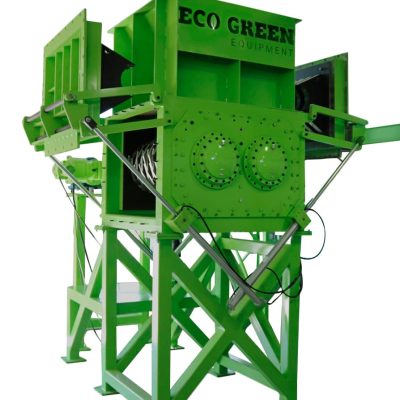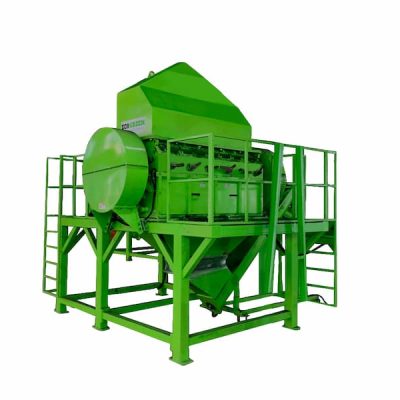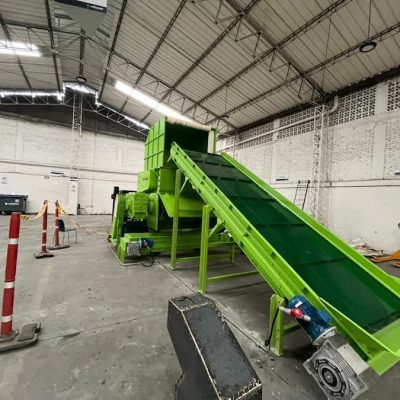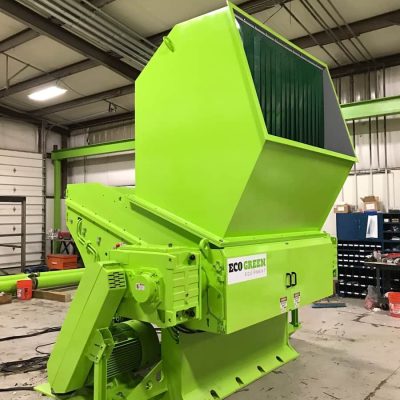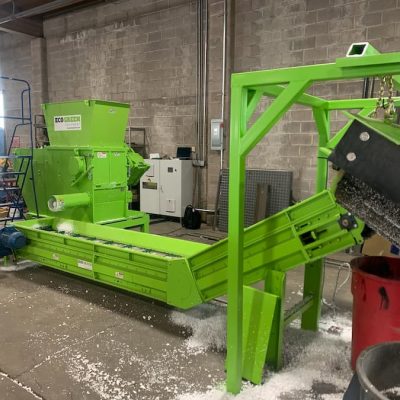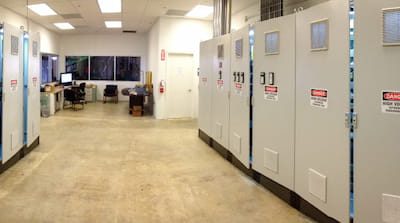E-Waste
Recycling Equipment
According to the World Health Organization (WHO), the amount of electronic waste, or e-waste, produced worldwide is growing faster than any other type of solid waste. This rapid growth poses a problem to the environment as we grapple with the question of how to dispose of it.
In 2024, the United Nations Institute for Training and Research (UNITAR) released statistics collected about e-waste. They found that in 2022, people worldwide produced 62 million metric tons of electronic waste and less than a quarter of that waste was reported as being properly recycled. Given the current trends, they predict that in 2030, the number will rise to 82 million metric tons of electronic waste.
The growth of electronic waste ties directly to technology trends worldwide, including increasing adoption of electronics, advances in technology that make older models obsolete, decreased life span of electronic products, and few repair options. The consumer’s desire to keep up with the latest upgrades combined with a lack of recycling infrastructure is creating a growing problem worldwide. While designed to take on tires, including OTR and mining, the recycling equipment we sell at ECO Green is an excellent option for recycling lines of all sorts, including electronics.
Is E-waste Recyclable?
Yes! While electronics contain various components and materials, modern electronics recycling equipment can shred them, allowing recycling companies to extract many materials, including rare earth metals, aluminum, copper, steel, and plastic. Following proper recycling processes can reduce environmental toxic waste and allow manufacturers to reuse many materials. Reuse reduces dependence on other countries for these rare elements.
Recyclers skilled in extracting these materials have the opportunity to build profitable e-waste recycling businesses, as the natural resources discarded as part of e-waste each year are worth billions of dollars.
How is E-waste Recycled?
- Manual Decontamination
Before recyclers can physically process electronic waste, they must remove any hazardous substances or materials, including television and monitor tubes, ink and toner cartridges, batteries, and light bulbs containing mercury. Removing and disposing of these materials properly is a vital step in e-waste recycling. It prevents environmental contamination and reduces health hazards. - Shredding
Next, an electronic waste shredder physically breaks the electronics into smaller pieces. These powerful machines easily break down hard drives (including SSDs), desktop computers, cell phones, circuit boards, and mainframes. In the process, these electronic waste recycling machines also free materials from one another, making it easier to separate them for recycling. - Materials Separation
After shredding, the electronic waste undergoes sorting using magnets, air jets, water currents, and infrared cameras. This step separates particles exiting the electronic recycling machines into metals, circuit boards containing precious metals, plastics, and other materials.
Computer Recycling Equipment
While they serve many functions throughout the world, computers are virtually the same in composition. Made of primarily metals, glass, plastic, foam, and internal circuitry, many of the materials contained in modern computers are recyclable. Using desktop shredders to break down computers and then extract and separate individual materials is the key to reusing and recycling them.
End of life legislation in many countries requires that electronics containing sensitive data undergo physical destruction. Whereas data erased from a hard drive may be recovered, physically dismantling drives, circuit boards, and other computer components renders the information on them unrecoverable. As of 2024, 31 states have laws governing the disposal of digital data. We expect this number to continue growing, carrying with it greater demand for accessible data destruction.
Hard drive shredders are excellent tools for destroying sensitive digital data. They reduce hard drives into small pieces, making them impossible to reassemble and read. Hard drive and SSD shredders also prepare the components of these drives for recycling. Recycling this e-waste helps companies comply with local laws and keeps electronic waste from reaching landfills.
Since circuit boards can also store personal information or proprietary data, many companies choose physical shredding to safeguard against information theft. Circuit board shredders reduce them into small pieces from which recyclers can remove precious metals, such as gold, silver, and palladium, leaving behind bits of plastic and copper wire.
Because computers are so common in households and businesses worldwide, a computer shredder capable of shredding hard drives, circuit boards, and other components is a must-have piece of equipment for any electronics recycler. ECO Green’s line of shredders can make short work of modern consumer and commercial computers, allowing you to help clients destroy their sensitive data and profit from recycling the inner materials.
Cabling and Wire Recycling Equipment
Over the past two decades, the price of copper has been climbing. This increase is largely due to the rising demand for electronics. Copper wiring is an essential component in computers, electrical cords, and other equipment. Because it is a finite resource that is easily recycled into high-quality metal, cable and wire recycling is an excellent business prospect.
The primary function of a cable wire recycling machine is to separate the metal from the outside casing of the wire. As separating long strings of cables would be cumbersome and time-consuming, the first step in the recycling process is to break the wire down into small particles of metal and plastic granules. A wire granulator or cable shredder physically reduces the size of the wires fed into the machine.
Every step after the initial trip through the wire shredder helps separate the plastic from the metal, ensuring the end product is as pure as possible. Magnets can pull most metal fragments from the shreds for wires containing ferrous metals. However, screening, airflow, and vibration may help to refine the separation further.
Solar Panel Recycling Equipment
Solar panels are popping up everywhere as the world strives to implement green energy and reduce dependence on fossil fuels. They cover the roofs of homes and businesses, and solar farms are beginning to dot the landscape. Their environmental impact is next to zero, until they wear out. The US Office of Energy Efficiency and Renewable Energy states that the average expected life for solar systems ranges from 30-35 years. This number does not take into account consumers who may choose to upgrade their panels early to take advantage of technology advances.
What then?
To keep solar panels from filling landfills and becoming the next environmental crisis, the implementation of solar panel recycling equipment needs to catch up to the production of end of life solar panels. While researchers look for solutions to make panels longer lasting and easier to recycle, reusing the materials within existing panels in new panels or new products will help solar energy keep its place among renewable and green energy sources.
Most solar panels in use today contain materials recyclable with existing recycling streams. These materials include:
- Glass
- Aluminum
- Plastic
- Copper
Solar panel recycling machines break down full panels into smaller pieces, allowing for easy separation of these materials from the panel.
Other materials, such as batteries and inverters, are e-waste and require special processing. Other components still need established recycling processes. However, the growing adoption of solar panels will inevitably lead to demand for better ways to recycle them.
White Goods Recycling Equipment
A modern term used to refer to common, large household appliances, including dishwashers, refrigerators, water heaters, washers, dryers, air conditioning units, and ranges, white goods present a particular challenge when it comes to proper disposal. Not only are these appliances bulky, taking up a large amount of space in landfills, but many contain substances that are harmful to the environment. Luckily, nearly half of US states have laws governing the disposal of these items.
While it varies from one appliance to the next, the average large household appliance is 75% steel. A durable and magnetic metal, steel is easily extracted from appliances and recycled into new steel using white goods recycling machines. White goods recycling is both a wise disposal option and a profitable business move for recyclers.
Recycling White Goods
Unlike other electronics, white goods do not run on electricity alone. They often contain specialized substances that allow them to perform specific functions. Oil, mercury, PCBs, and Freon are common in end-of-life appliances. These substances must be removed before the appliance can be recycled. In the case of Freon, the removal process requires expert skills and exact adherence to established procedures to capture all CFCs and avoid ozone damage.
After decontamination, they are ready for shredding. The first step of electronics recycling equipment, shredders are key to breaking down electronics for further processing. These machines, which may be single or twin-shaft, feature rotating knives or blades that shred full-size appliances into smaller pieces. A secondary shredder may be helpful if further breakdown is necessary.
Subsequent machines on the recycling line help sort particles by material. Magnets separate ferrous or magnetic metals from aluminum, and forced air and water streams help separate foam from plastic fragments.
As the process for recycling many appliances is the same, purchasing high-quality refrigerator recycling machines will create a recycling line capable of processing a wide variety of appliances. A top priority for any recycler should be investing in recycling machinery that is both capable, durable, and efficient, and ECO Green is proud to help.
Here are a few criteria to help you choose the best equipment whether you are shopping for air conditioner recycling machines or other recycling equipment.
Efficiency
Like the paper shredder in the office, all shredders produce smaller pieces from the material you put into them. What happens inside the machine, however, can significantly affect what you get out of it. If you want to recycle enough washing machines to be profitable, look for a washer recycling machine with a high throughput and reliably produces the same output. Shredders like the ECO Green Giant feature two shafts that process up to 30 metric tons of tires per hour.
Upkeep
The blades or knives in shredding machines wear down over time. Sharpening, rotating, or replacing these cutting surfaces is part of regular machine maintenance. Choosing machines that keep maintenance simple is wise. With easy-access maintenance doors, ECO Green cutting blades are readily accessible and have six cutting surfaces to extend the use time between sharpenings.
Updates
Leaders in commercial recycling equipment are constantly innovating to improve the speed and efficiency of their electronic recycling equipment. At ECO Green, we believe that improving recycling processes will help make recycling more profitable for recyclers and more cost-effective for consumers. Ultimately, innovation will drive more companies and individuals to embrace this essential practice.
Low Operational Cost
While we don’t recommend buying budget equipment, we do believe that budgeting is a wise business practice. To improve your bottom line, find equipment that uses energy efficiently, producing more and requiring less to keep it running. Clothes dryers contain significant amounts of steel. If you can recover this metal quickly and efficiently with the right dryer recycling equipment, you can help ensure healthy profits for your recycling line.
E-Waste Recycling Equipment
Electronic waste encompasses a wide variety of products. In fact, it is a category broad enough to include almost any device that has a plug or a battery. Unfortunately, the worldwide dependence on these electronics to clean our homes, run our businesses, and make our lives easier is increasing our production of waste nearly exponentially. The time for entrepreneurs to embrace the opportunities available in electronics recycling is now. E-waste recycling machinery manufacturers like ECO Green are stepping up to provide the equipment.
Whether you are an experienced recycler looking to expand your business into a new market by adding e-waste recycling machines to your line or an entrepreneur who wants to jump on a great opportunity to fill a growing need, the team at ECO Green can help you get started. We have been refining our line of shredders, granulators, sorting, conveying, and bagging equipment since 2001.
Innovation is an integral part of what we do at ECO Green. We strive to stay ahead of the curve and meet the growing recycling needs of our clients and their customers. Tested on some of the world’s largest and toughest tires, our shredders are proven and ready to take on new challenges as e-waste shredders to help keep toxic chemicals out of the environment and encourage the reuse of existing materials.
The world around us has a finite supply of the resources we need for our electronics. Demand for elements such as copper has increased substantially in recent years driving the price up for manufacturers and profits up for recyclers. E-waste grinders are a key piece to unlocking the earning potential of an expert recycler.
Getting Started Recycling E-waste
If you are interested in joining the ranks of other e-waste recycling companies and improving recycling practices in the United States or abroad, call the team at ECO Green. Our knowledgeable multinational team can help you identify the electronics recycling equipment you need to build a top-of-the-line recycling business. We are located in Utah, but we have supplied recycling equipment to companies all over the world, and we look forward to helping you as well.

